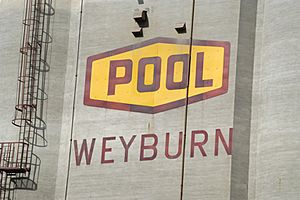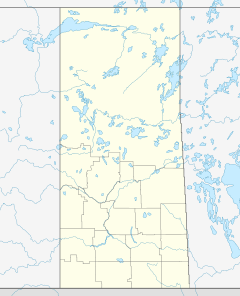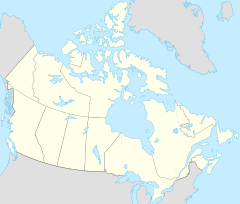Weyburn facts for kids
Quick facts for kids
Weyburn
|
||
|---|---|---|
|
City
|
||
| City of Weyburn | ||
 |
||
|
||
| Nickname(s):
The Opportunity City
|
||
| Motto(s):
"Vision, Achievement, Progress"
|
||
| Country | Canada | |
| Province | Saskatchewan | |
| Census division | 2 | |
| Area | ||
| • Total | 15.78 km2 (6.09 sq mi) | |
| Elevation | 561 m (1,841 ft) | |
| Population
(2021)
|
||
| • Total | 11,019 | |
| Forward sortation area |
S4H
|
|
| Website | City of Weyburn | |
Weyburn is a city in Saskatchewan, Canada. It is the tenth-largest city in the province. About 11,019 people live here. Weyburn is located on the Souris River. It is about 110 kilometers (68 miles) southeast of Regina, the provincial capital. The city is also about 70 kilometers (43 miles) north of the North Dakota border in the United States. The name "Weyburn" might come from the Scottish words "wee burn," which mean a small creek. The city is surrounded by the Rural Municipality of Weyburn No. 67.
Contents
- History of Weyburn: How the City Grew
- People of Weyburn: Population Changes
- Geography and Climate: Weyburn's Environment
- Economy: What Drives Weyburn's Success
- Culture and Museums: Exploring Weyburn's Past
- Education: Schools and Learning in Weyburn
- Infrastructure: How Weyburn Works
- Sports and Recreation: Fun in Weyburn
- Local Media: News and Entertainment
- Notable People: Famous Faces from Weyburn
- Images for kids
History of Weyburn: How the City Grew
Weyburn started to grow because of the railways. The Canadian Pacific Railway (CPR) arrived in 1892. The Soo Line followed in 1893. These railways connected Weyburn to other important places.
A post office opened in 1895. A land office started in 1899. This was because many people were expected to move to the area. In 1899, Knox Presbyterian Church was founded. Its building was finished in 1906. This church showed the hope and belief of the people in Weyburn.
Weyburn officially became a village in 1900. It became a town in 1903. Finally, it became a city in 1913. From 1910 to 1931, the Weyburn Security Bank was based in the city. This shows how important Weyburn was becoming.
Weyburn was a key railway town in Saskatchewan. Many railway lines passed through it. These lines helped transport goods and people.
People of Weyburn: Population Changes
| Historical populations | ||
|---|---|---|
| Year | Pop. | ±% |
| 1901 | 113 | — |
| 1911 | 2,210 | +1855.8% |
| 1921 | 3,193 | +44.5% |
| 1931 | 5,002 | +56.7% |
| 1941 | 6,119 | +22.3% |
| 1951 | 7,148 | +16.8% |
| 1961 | 9,101 | +27.3% |
| 1971 | 8,815 | −3.1% |
| 1981 | 9,523 | +8.0% |
| 1991 | 9,673 | +1.6% |
| 2001 | 9,534 | −1.4% |
| 2006 | 9,433 | −1.1% |
| 2011 | 10,484 | +11.1% |
| 2016 | 10,870 | +3.7% |
| 2021 | 11,019 | +1.4% |
| Source: Statistics Canada | ||
In 2021, Weyburn had a population of 11,019 people. This was a small increase from 2016. The city is growing steadily. Weyburn covers an area of about 19.03 square kilometers (7.35 square miles). This means there are about 579 people per square kilometer.
Geography and Climate: Weyburn's Environment
Weyburn is located near the upper part of the Souris River. This river is about 700 kilometers (435 miles) long. It flows southeast into North Dakota and then to Manitoba.
Long ago, this area was a large marshland. Now, there are special projects to control floods. These projects have created reservoirs and parks. They are also important places for waterfowl. The Rafferty-Alameda Project was built between 1988 and 1995. It helps prevent spring flooding from the Souris River.
Weather in Weyburn: Hot Summers, Cold Winters
Weyburn has a humid continental climate. This means it has warm summers and cold winters. This type of climate is common in Southern Saskatchewan.
| Climate data for Weyburn, 1981–2010 normals, extremes 1916–present | |||||||||||||
|---|---|---|---|---|---|---|---|---|---|---|---|---|---|
| Month | Jan | Feb | Mar | Apr | May | Jun | Jul | Aug | Sep | Oct | Nov | Dec | Year |
| Record high °C (°F) | 11.5 (52.7) |
16.0 (60.8) |
23.5 (74.3) |
32.2 (90.0) |
37.5 (99.5) |
40.5 (104.9) |
42.5 (108.5) |
40.0 (104.0) |
38.0 (100.4) |
31.1 (88.0) |
24.0 (75.2) |
14.5 (58.1) |
42.5 (108.5) |
| Mean daily maximum °C (°F) | −8.2 (17.2) |
−5.4 (22.3) |
1.4 (34.5) |
11.9 (53.4) |
18.6 (65.5) |
23.2 (73.8) |
26.5 (79.7) |
26.2 (79.2) |
19.6 (67.3) |
11.4 (52.5) |
0.8 (33.4) |
−6.1 (21.0) |
10.0 (50.0) |
| Daily mean °C (°F) | −13.5 (7.7) |
−10.5 (13.1) |
−3.6 (25.5) |
5.2 (41.4) |
11.7 (53.1) |
16.7 (62.1) |
19.6 (67.3) |
18.8 (65.8) |
12.5 (54.5) |
5.1 (41.2) |
−4.2 (24.4) |
−11.1 (12.0) |
3.9 (39.0) |
| Mean daily minimum °C (°F) | −18.8 (−1.8) |
−15.6 (3.9) |
−8.7 (16.3) |
−1.5 (29.3) |
4.8 (40.6) |
10.1 (50.2) |
12.7 (54.9) |
11.4 (52.5) |
5.5 (41.9) |
−1.3 (29.7) |
−9.1 (15.6) |
−16.2 (2.8) |
−2.2 (28.0) |
| Record low °C (°F) | −42.9 (−45.2) |
−41.9 (−43.4) |
−41.1 (−42.0) |
−30.6 (−23.1) |
−13.3 (8.1) |
−3.9 (25.0) |
−2.2 (28.0) |
−2.2 (28.0) |
−13.3 (8.1) |
−20.6 (−5.1) |
−34.0 (−29.2) |
−42.0 (−43.6) |
−42.9 (−45.2) |
| Average precipitation mm (inches) | 19.7 (0.78) |
11.9 (0.47) |
22.2 (0.87) |
27.6 (1.09) |
56.8 (2.24) |
75.5 (2.97) |
66.1 (2.60) |
47.5 (1.87) |
33.2 (1.31) |
24.2 (0.95) |
18.5 (0.73) |
20.8 (0.82) |
423.9 (16.69) |
| Average rainfall mm (inches) | 0.7 (0.03) |
0.8 (0.03) |
6.1 (0.24) |
19.2 (0.76) |
51.3 (2.02) |
75.5 (2.97) |
66.1 (2.60) |
47.5 (1.87) |
32.1 (1.26) |
16.4 (0.65) |
2.2 (0.09) |
0.5 (0.02) |
318.2 (12.53) |
| Average snowfall cm (inches) | 19.0 (7.5) |
11.1 (4.4) |
16.1 (6.3) |
8.3 (3.3) |
5.5 (2.2) |
0.0 (0.0) |
0.0 (0.0) |
0.0 (0.0) |
1.1 (0.4) |
7.8 (3.1) |
16.4 (6.5) |
20.3 (8.0) |
105.7 (41.6) |
| Mean monthly sunshine hours | 98.0 | 125.4 | 150.4 | 222.7 | 268.3 | 309.4 | 353.0 | 294.5 | 192.5 | 176.0 | 117.3 | 80.1 | 2,387.7 |
| Percent possible sunshine | 36.5 | 44.0 | 40.9 | 54.1 | 56.4 | 63.6 | 71.9 | 65.8 | 50.7 | 52.6 | 42.8 | 31.4 | 50.9 |
| Source: Environment Canada | |||||||||||||
Economy: What Drives Weyburn's Success
Weyburn is a major center for grain in Canada. It is the largest inland grain gathering point. Over half a million tons of grain pass through Weyburn each year. This makes agriculture very important to the city.
Oil and gas exploration are also big parts of Weyburn's economy. These industries create many jobs and help the city grow.
Culture and Museums: Exploring Weyburn's Past
Weyburn has interesting places to visit. The Soo Line Historical Museum was built around 1910. It is a special heritage property. It helps people learn about the area's history.
Weyburn is also home to the world's first curling museum. It is called the Turner Curling Museum. If you like sports history, this is a cool place to see!
Education: Schools and Learning in Weyburn
Weyburn offers many educational opportunities.
Elementary and Secondary Schools
The public school system is called South East Cornerstone School Division No. 209. It runs several schools:
- Assiniboia Park Elementary School
- Legacy Park Elementary School
- Weyburn Comprehensive High School
Some older schools like Haig School, Queen Elizabeth School, and Souris School have closed. Their students moved to Legacy Park Elementary School in 2021. Weyburn Junior High School also closed in 2016. Its students moved to Weyburn Comprehensive High School.
The separate school system is Holy Family Roman Catholic Separate School Division No. 140. It operates St. Michael School.
Colleges and Higher Learning
Southeast College offers different programs. These include technical and trade courses. They also have non-degree programs. You can even take distance learning courses from the University of Regina and University of Saskatchewan here.
Public Library
The Weyburn Public Library is part of the Southeast Regional Library system. It's a great place to find books and learn new things.
Infrastructure: How Weyburn Works
Transportation: Getting Around Weyburn
Weyburn is located where three highways meet: Highway 13, Highway 35, and Highway 39. This makes it easy to travel to and from the city. The Weyburn Airport is just northeast of the city.
Utilities: Services for the City
SaskPower provides electricity to Weyburn. SaskEnergy provides natural gas. The city manages its own water treatment plant. It also handles its own waste management. Weyburn gets its water from Nickle Lake. For phone and internet, you can choose between SaskTel and Access Communications.
Sports and Recreation: Fun in Weyburn
Weyburn is a great place for sports! It is home to the Weyburn Red Wings. They play in the Saskatchewan Junior Hockey League (SJHL). The Weyburn Beavers are also here. They play in the Western Canadian Baseball League. This is a summer baseball league for college players. Weyburn also has Saskatchewan's largest amateur wrestling club.
Local Media: News and Entertainment
Radio Stations
Golden West Broadcasting runs three radio stations in Weyburn:
- CFSL 1190 AM plays classic hits.
- CKRC-FM 103.5 plays hot adult contemporary music.
- CHWY-FM 106.7 plays country music.
All these stations share a news website called Discover Weyburn. Their studios are in downtown Weyburn.
Newspapers
Glacier Media Group publishes three newspapers for Weyburn and the surrounding area:
- the Weyburn Review
- the Weyburn and Area Booster
- Weyburn This Week
Notable People: Famous Faces from Weyburn
Many talented people have come from Weyburn!
- Tenille Arts - a country music singer
- Pat Binns - a former leader of Prince Edward Island
- Graham DeLaet - a professional golfer
- Shirley Douglas - an actress
- Tommy Douglas - a famous politician who was voted The Greatest Canadian in 2004
- Larry Giroux - played in the NHL for several teams
- Brett Jones - a professional football player
- Guy Gavriel Kay - a well-known writer
- Trenna Keating – an actress
- Brendon LaBatte - a professional football player
- W. O. Mitchell - a writer
- Dave "Tiger" Williams - a former professional hockey player
Images for kids







